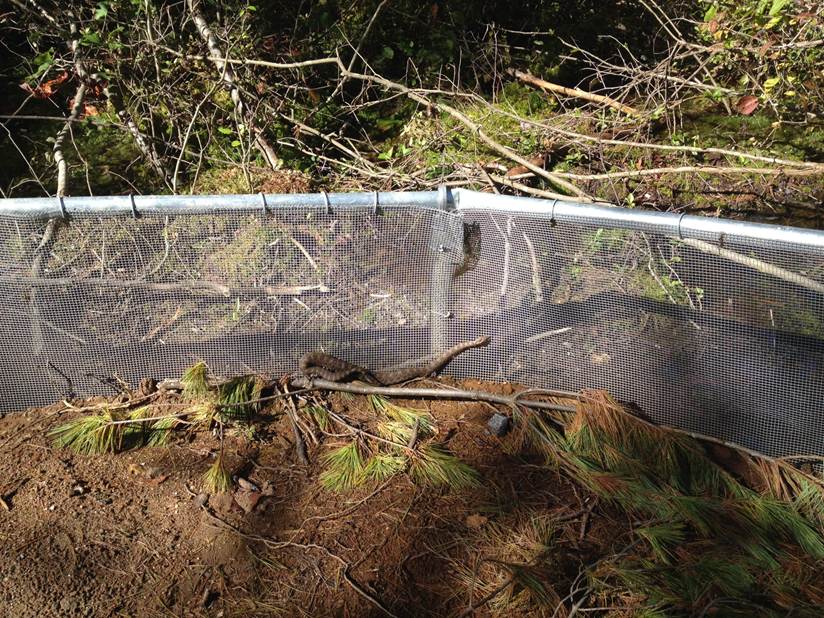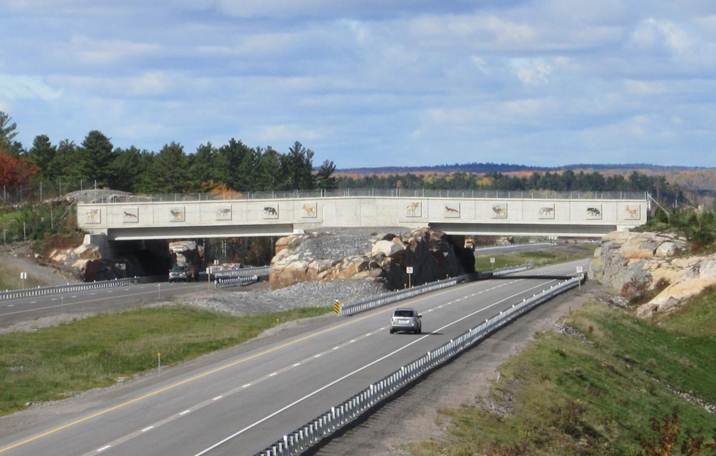One of the most important impacts of roads on wildlife populations is the direct mortality of animals as they are hit and killed by vehicles. In Ontario alone, there are approximately 14,000 wildlife/vehicle collisions reported each year (almost all involving large herbivores such as deer). There are many more unreported collisions involving smaller mammals, birds, reptiles and amphibians (Ontario Road Ecology Group 2010). For instance, over a 5-month study period, more than 24,000 vehicle-vertebrate collisions were documented on a 31 km stretch of the Thousand Islands Parkway in Eastern Ontario (Eberhardt 2008). Wildlife/vehicle collisions also pose a serious safety risk for motorists across Canada, and they are increasing annually. Prior to the last decade, wildlife collision reduction efforts in Ontario were primarily limited to installing wildlife warning signs and no discernable reduction in wildlife collisions was observed.
In 2005, the Ontario Ministry of Transportation (MTO), Northeastern Region, commenced a more proactive approach to reducing wildlife/vehicle collisions by installing emerging mitigation methods such as crossing structures and fencing on both Highway 11 and 69. To date, the most extensive mitigation in Ontario is on Highway 69 between Parry Sound and Sudbury, where highway expansion and upgrades are currently being completed and one wildlife overpass, one underpass, twenty-seven one-way gates, two Texas gates (cattle grids), and 10 km of fencing have been installed. In September 2011, mitigation effectiveness monitoring was initiated on this section of highway. Key results have shown that more species are using the wildlife overpass over time and that most animals, such as Moose and White-tailed Deer prefer the wildlife overpass to the wildlife underpass. Preliminary data have shown a reduction in wildlife/vehicle collisions in the fenced section, and no Moose and Elk have breached the fencing system. Long-term monitoring is required to assess overall effectiveness of the crossing structure and fencing systems for all wildlife populations in the study area. Monitoring efforts are ongoing and are expected to produce additional results, such as an assessment of Black Bear population-level use of wildlife crossings through DNA analysis conducted on hair and scat samples.
Figure 1. Highway 69 wildlife overpass (credit: Ontario Ministry of Transportation).
The eastern Georgian Bay and Bruce Peninsula Massasauga Rattlesnake populations are believed to be the largest and most secure found anywhere across the species’ entire range. The future Highway 69 expansion (from two lanes to four-lanes) from Parry Sound to Sudbury will be built through the eastern Georgian Bay Massasauga habitat, and as such, will be one of the most permeable highways in Canada. At this stage of the design, the MTO is planning to construct 93 eco-passages (large crossings underneath the highway that provide safe passage for wildlife) which will include approximately 140 kilometres (km) of fencing designed to keep the Massasauga Rattlesnake off of the roadway and to funnel them towards the eco-passages.

Figure 2. Massasauga Rattlesnake prevented from accessing highway by fence (credit: Ontario Ministry of Transportation).
Figure 2. Massasauga Rattlesnake prevented from accessing highway by fence (credit: Ontario Ministry of Transportation).
MTO has also recently engaged in a project to develop a Wildlife Mitigation Strategy with the aim of advancing MTO’s knowledge and capabilities in key areas related to wildlife-roadway interactions. These include: monitoring and data collection for terrestrial species; GIS analysis for “hotspot” mapping; state-of-the art wildlife mitigation measures; and public awareness techniques.
The Wildlife Mitigation Strategy project will also encourage the inclusion of biodiversity conservation into MTO highway projects by: providing science-based decision-planning tools in a geographic information system; and an update to MTO’s Environmental Guide for Wildlife Mitigation, which will assist MTO staff in strategic and prioritized implementation of wildlife mitigation measures. These include new Wildlife Habitat Awareness signs, which are being tested for effectiveness during the project at pilot locations. The Wildlife Mitigation Strategy will continue to evolve, with the first generation completed in December, 2014 and plans for future generations to expand beyond MTO.
References
Eberhardt, E. 2008. Current and potential wildlife fatality hotspots along the Thousand Islands Parkway in eastern Ontario, Canada. M.Sc. Thesis, Department of Geography and Environmental Studies, Carleton University, Ottawa, ON.
Ontario Road Ecology Group, Toronto Zoo. 2010. A guide to road ecology in Ontario, prepared for the Environment Canada Habitat Stewardship Program for Species at Risk. Scarborough, ON.

